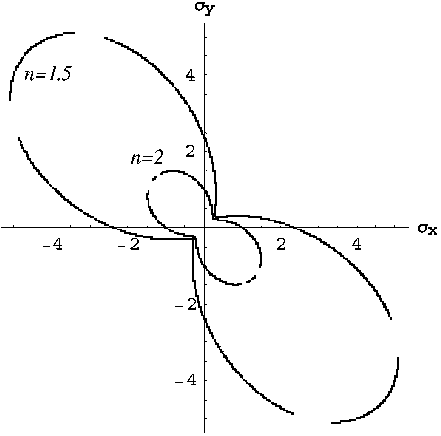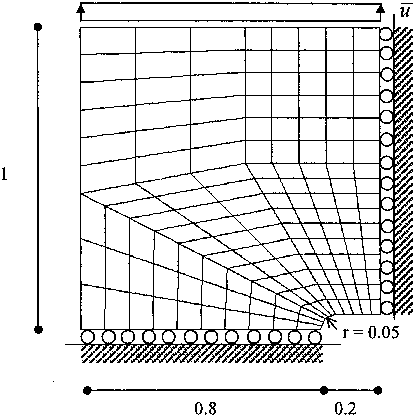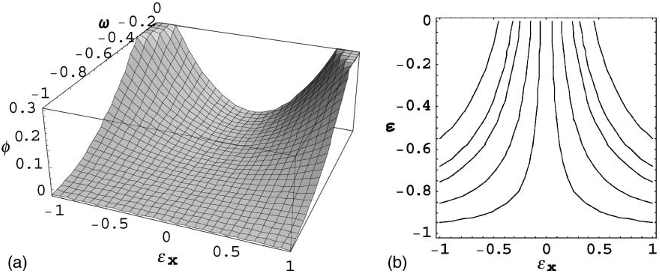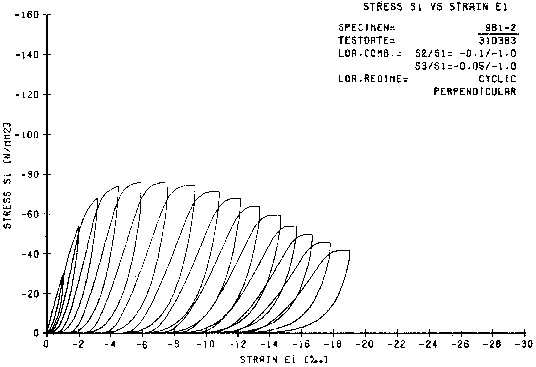A new thermodynamically consistent continuum model for hardening plasticity coupled with damage
Summary (3 min read)
Introduction
- The documents may come from teaching and research institutions in France or abroad, or from public or private research centers.
- The main characteristics of the proposed model are summarised in the following.
- First, an unified format for the evolution laws of any internal variable is obtained, and they all derive from a single potential of the driving forces.
2.1. State variables and ambient spaces
- A simple material is considered and the constitutive relations are developed within the framework of the Generalised Standard Material Model (Germain, 1973; Halphen and Nguyen, 1975).
- The assumption of local state is kept valid, i.e. the equilibrium state of a material point is assumed independent of the state of the neighbouring elements.
- The state of the system is phenomenologically described assigning a set of internal variables and the related mechanisms for energy exchange, distinguishing the reversible phenomena that modify the stored energy and the irreversible ones that cause energy dissipation.
- The last term in (2) represents the heat exchange while the other terms correspond to the mechanical power.
- Since for any closed system the power of the internal variables a, x must be zero, their total value vanishes, i.e. their elastic and plastic parts are opposite (Kluitenberg, 1962; Ziegler, 1977).
2.2. Internal energy functional
- The internal energy, dependent only on the reversible part of the kinematic variables, is postulated as the sum of a deformation energy /ðee;xe; seÞ and of a hardening energy wðae;xe; seÞ coupled with damage: eðee; ae;xe; seÞ ¼ /ðee;xe; seÞ þ wðae;xe; seÞ þ InXðxeÞ ð6Þ.
- In the sequel, as isothermal processes are considered, the dependence on entropy or temperature will be dropped.
- Furthermore, the function EðxeÞ can be assumed convex in xe.
- The form (8) has been often used in mechanics, and is based on the idea of the ‘‘effective stress’’ r̂, first proposed by Kachanov (1958).
- The operators M1, M2 are in general fourth order tensor (Hansen and Schreyer, 1994).
2.3. The dissipation functional
- The irreversible behaviour is ruled by the dissipation potential d, that has to comply with the second principle of thermodynamics, stating the irreversibility of entropy production (Chaboche, 1999): q_sþ div q T r T P 0 ð22Þ where q is the material density, r the density of the internal heat production and q the heat flux for unit area.
- Eq. (34) implies that the dissipation functional is equal to the support function of the convex domain K : dð _gpÞ ¼ suppK ð35Þ.
- Furthermore, forms of the internal energy or of the dissipation potential different from those used in the paper can be applied, subjected only to the thermodynamic restrictions (28).
- Additional degrees of freedom can be obtained if the exponent n of the damage law is assumed to be different for the elastic and the plastic moduli.
3. The admissible domain
- In paragraph 2 it has been shown that the maximum dissipation principle (34) implies the existence of an elastic domain K of the generalised stresses that can be described by means of the yield functional (43).
- Aim of this paragraph is to examine and compare some of them with the present model.
- All the convex domains having their borders between the solid and the dashed lines in Fig. 4, corresponding to different choices of the dissipation d, are admissible.
- Two distinct Lagrangian multipliers are thus introduced.
- The admissible domain (53) in the uniaxial case is examined in Fig. 7 where the undamaged elastic path for uniaxial stress is represented.
4.1. The case of isotropic damage
- The functions g1 and g2 are the classical expressions of the Mises and Drucker-Prager criteria with the addition of two variables: the isotropic hardening variable v, that rules the homothetic expansion of the plastic surface and the isotropic damage energy f, dual of the damage variable x, that describes the contraction of the domain when damage is active.
- A functional dependency on the stresses can also be introduced to reproduce coupling phenomena of plasticity and fracture.
- It is observed that the considered yield functions are all positively homogeneous, contrarily to the expressions obtained in the case an effective stress plastic criterion is used (see Eq. (53)).
- The model is completed by the elastic relations Eq. (17).
4.2. Predictions of the model
- The damage response of the model presented in Sections 2 and 4.1 is analysed considering some simple uniaxial processes.
- The loading unloading behaviour is considered in Fig. 9b.
- Due to the presence of damage the application of this model to structural problems will cause strain localisation with the consequent mesh-dependency of the numerical results.
- The parameters c and n particularly influence the degradation of the elastic modulus.
4.3. Multiaxial compression processes: comparison with experimental results
- The predictions of the model examined in Section 4.2 are compared to experimental data obtained from tests on confined concrete (Van Mier, 1984).
- In order to avoid the occurrence of localisation, only the data in the hardening phase, before the peak, are used.
- (Van Mier, 1984), from which the experimental relation elim1 rlim1 has been derived for comparison with the prediction of the model given by Eq. (65).
- Fig. 18. Envelope of limit uniaxial elastic states for hardening isotropically damaged material.
- Constant n. Fig. 21. Experimental degradation of the elastic modulus and model prediction for the test of Fig. 20.
5. Numerical algorithm
- As it has been previously observed, the numerical implementation of the presented coupled plastic model is a generalisation of the standard algorithm for elastoplasticity with internal variables.
- De, it can be found the algorithmic consistent tangent operator (Cuomo, submitted for publication) UepðeÞ ¼ sup s ½hg; si ecðsÞ dcðsÞ hg0p; si ð66Þ where the vector g0p collects the values of accumulated irreversible kinematic variables at the beginning of the step.
- The second form of (67) derives from an augmented Lagrangian Regularisation (Bertsekas, 1982) that turns the inequality constraint gi6 0 into the equality constraint gl ¼ 0 and has several advantages.
- This form is particularly useful in the case of corner points.
- The coupled Mises criterion (56) has been used for the material with different values of the material constant c. Fig. 25 shows the total reaction versus the imposed vertical displacement for three different values of the damage parameter c (c ¼ 0 is equivalent to absence of damage) in plane strain.
6. Conclusions
- An internal variable model of plasticity coupled with damage has been formulated in the framework of GSMM.
- Various damaging material behaviours have been modelled, as plastic-hardening or cohesive fracturelike behaviour, depending on the choice of the dissipation functional, and therefore of the generalised elastic domain.
- Consequently the evolution laws of any internal variable are obtained in a unified way.
- These can be easily identified by means of usual experimental tests.
- Several mechanical behaviours have been modelled, both in monotonic and in cyclic processes.
Did you find this useful? Give us your feedback
Figures (9)

Table 1 Comparison of experimental and numerical value of the peak stress and elastic strain for confined compressive tests on concrete, c 70; n 2; n2 3:5 
Fig. 5. Limit surface of function (53) E0 100, r0 1, n 1:5. 
Fig. 10. Uniaxial processes for n 1, 2, c 50, E 100. Mises criterion. 
Fig. 24. Slit problem. Geometry and load condition. 
Fig. 4. Uniaxial domain C and K for Eqs. (34) and (45). 
Fig. 1. Elastic potential /ðee;xeÞ and its level sets in an uniaxial case n 2. 
Fig. 20. Triaxial compressive stress strain curve. 
Fig. 3. Complementary energy functional in an uniaxial stress state, n 2. 
Fig. 2. Complementary energy functional in an uniaxial stress state. Section with planes r1 const, n 2.
Citations
186 citations
144 citations
122 citations
Cites methods from "A new thermodynamically consistent ..."
...Thus, we will indicate with Dð _ ep; _ apÞ the dissipation rate, given by Contrafatto and Cuomo (2002):...
[...]
106 citations
Cites background or methods from "A new thermodynamically consistent ..."
...The paper adopts a continuum phenomenological approach involving mechanical damage and applies the methodology introduced in Contrafatto and Cuomo (2002)....
[...]
...14, a comparison with an isotropic damage model (Contrafatto and Cuomo, 2002) is also reported, showing that -120 -100 -80 -60 -40 -20 0 20 hydrostatic stress = I1/31/2 0 5 10 15 20 25 d ev ia to ri c st re ss r = ( 2J 2) 1/ 2 vo lu m et ri c ca p Ottosen tensile meridian Ottosen compressive…...
[...]
...It is observed, to this purpose, that plasticity criteria based on effective stresses may not, in general, be compatible with the framework of simple materials (Contrafatto and Cuomo, 2002)....
[...]
...…and Nguyen, 1975) by simply defining appropriate internal energy and dissipation functionals, provided they are formulated in a fully coupled way in the extended space of the internal variables, according to the general plastic-hardening-damage model illustrated in Contrafatto and Cuomo (2002)....
[...]
...…redundant distinction between reversible and irreversible components of the internal damage variables (i.e. xe xp), is mainly motivated by the intention of distinguishing the kinematic variables that are responsible for storage energy and for dissipation, as stated in Contrafatto and Cuomo (2002)....
[...]
81 citations
Additional excerpts
...[48,49,107]) or by crack growth (see e....
[...]
References
4,047 citations
"A new thermodynamically consistent ..." refers background in this paper
...…ð67Þ where l is an arbitrary fixed positive (penalty) parameter and gl ¼ max gi; ki l l 2 R ð68Þ The second form of (67) derives from an augmented Lagrangian Regularisation (Bertsekas, 1982) that turns the inequality constraint gi6 0 into the equality constraint gl ¼ 0 and has several…...
[...]
...(41), only one multiplier is needed, so that efficient algorithms can be used for overcoming the numerical difficulties at corner points (Bertsekas, 1982)....
[...]
2,388 citations
1,278 citations
1,158 citations
"A new thermodynamically consistent ..." refers background in this paper
...…the plastic strain rates are consequently obtained including the damage variable as a parameter, which, in turn, is determined through a specific evolution law independent of the plastic potential (Hansen and Schreyer, 1994; Simo and Ju, 1987; Klisinski and Mr oz, 1988; Marotti de Sciarra, 1997)....
[...]
...The form (17) of the generalised elastic relation recovers the one used by many authors (Simo and Ju, 1987; Ju, 1989)....
[...]
865 citations